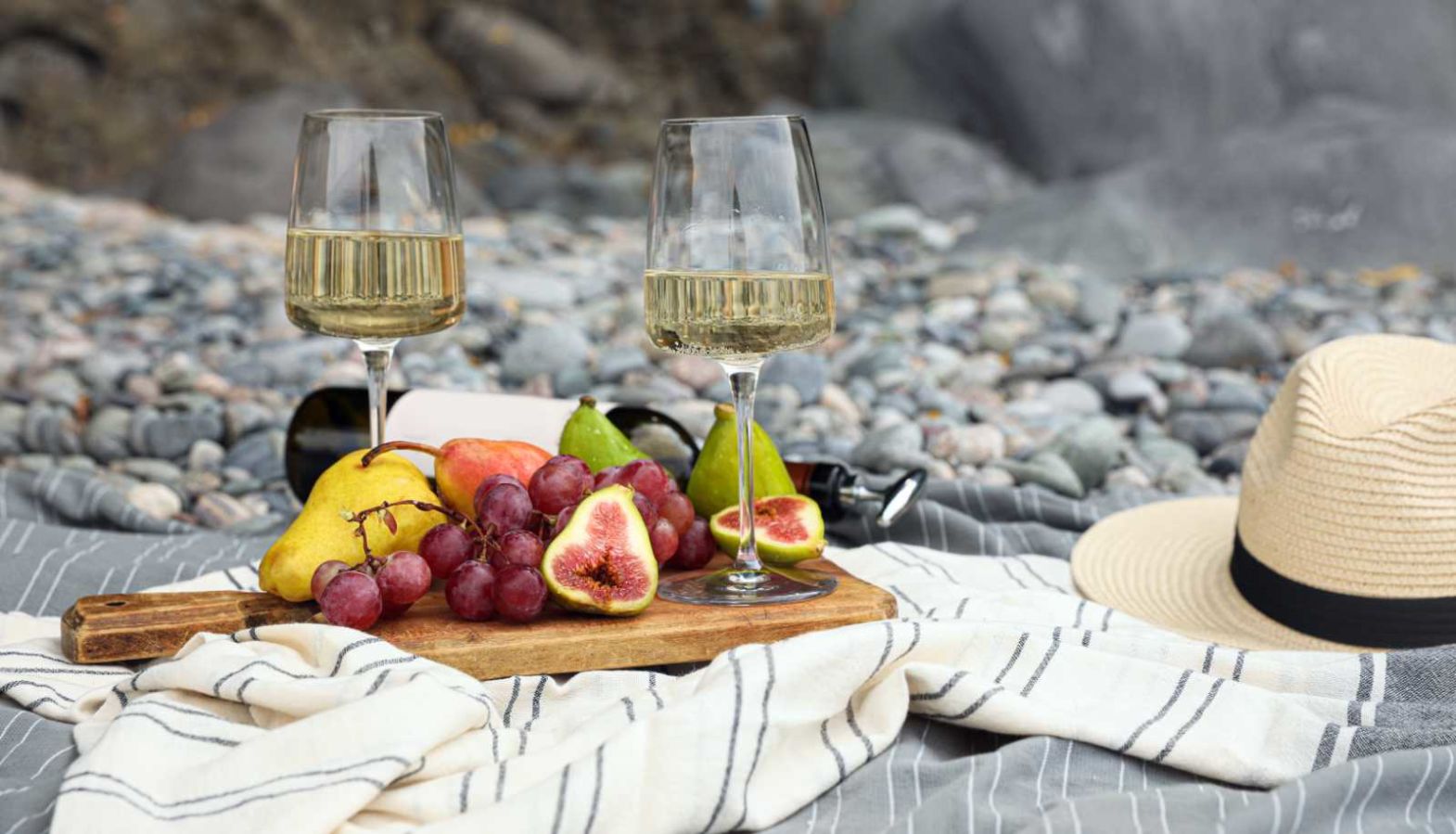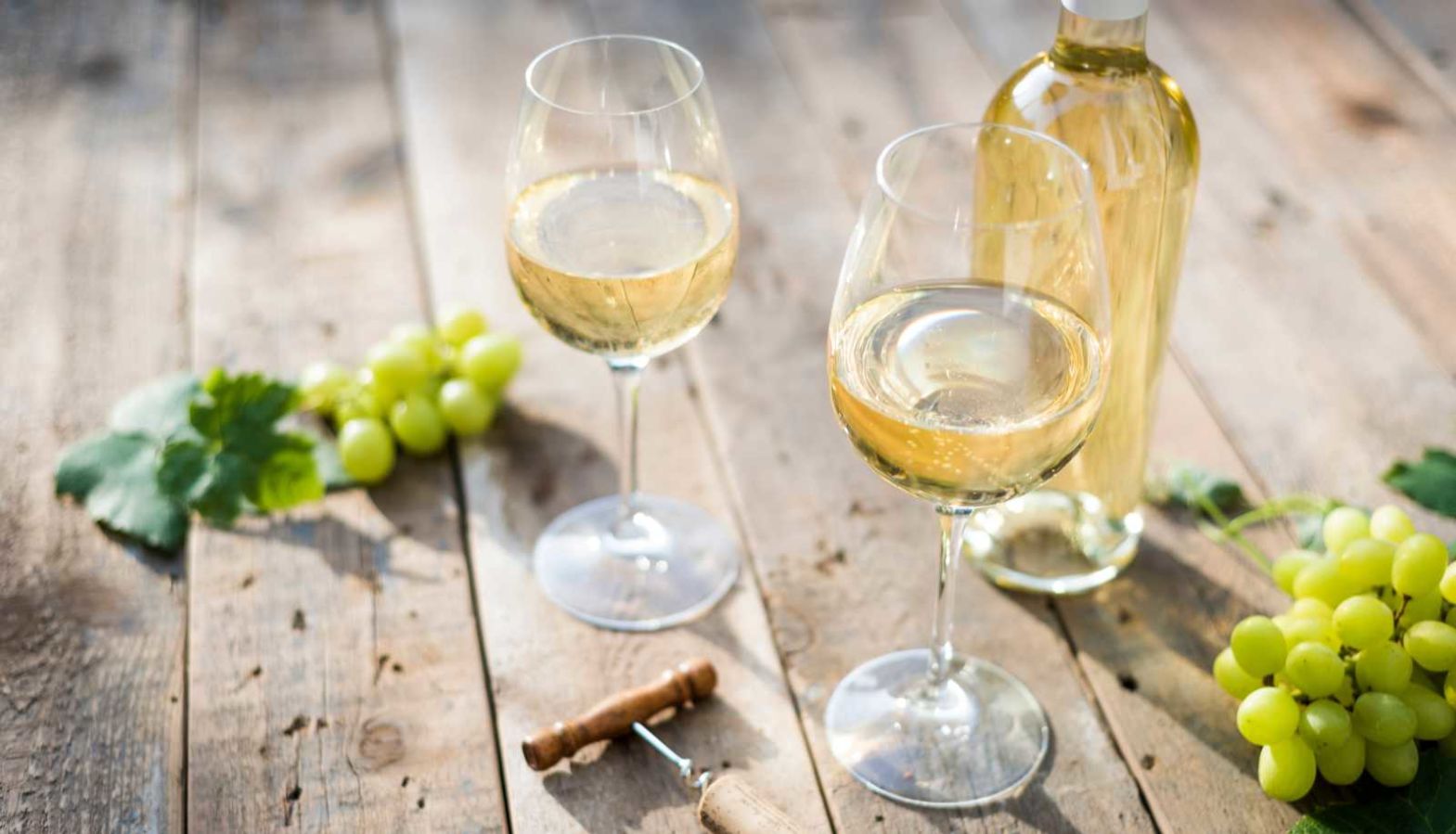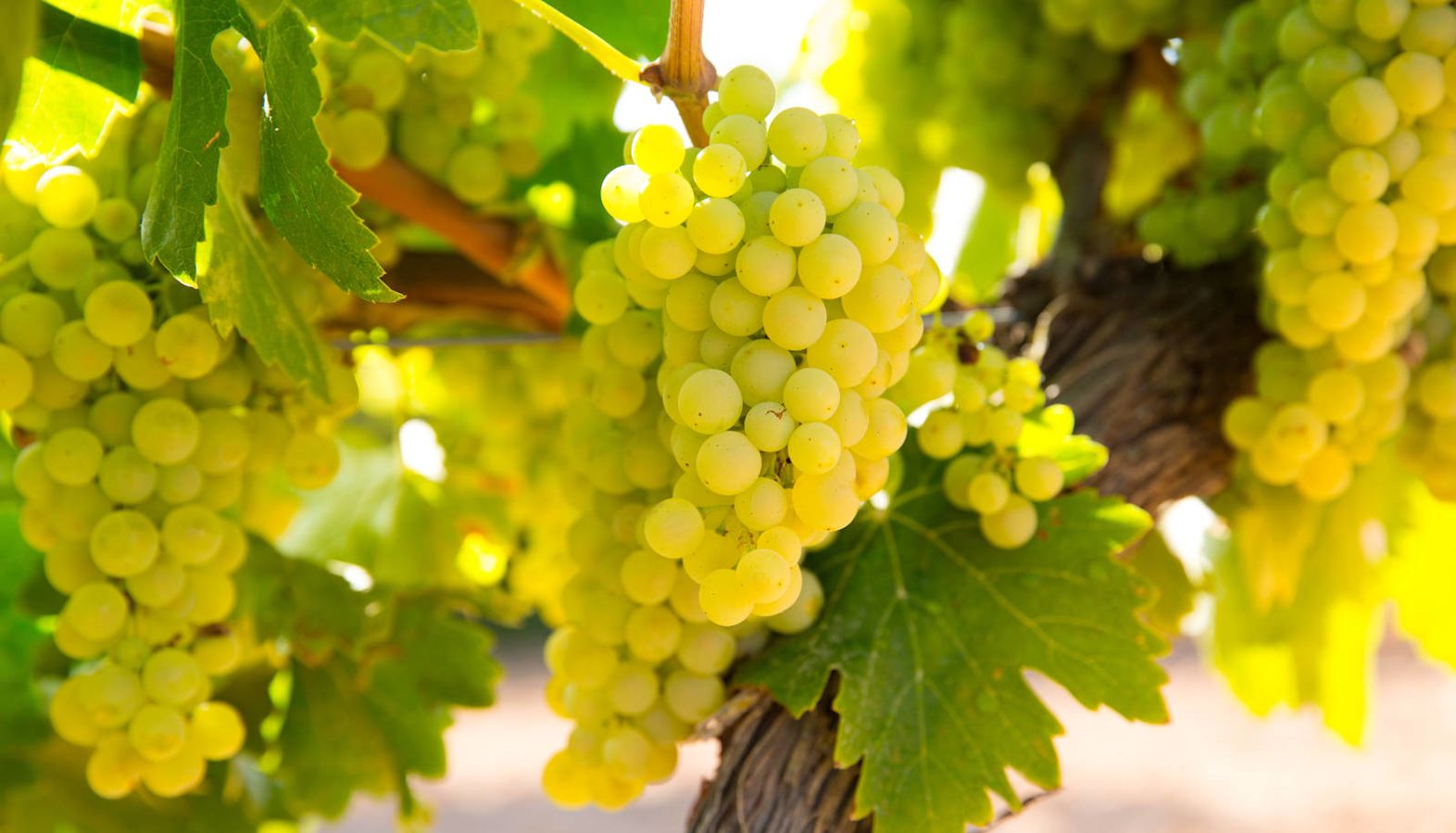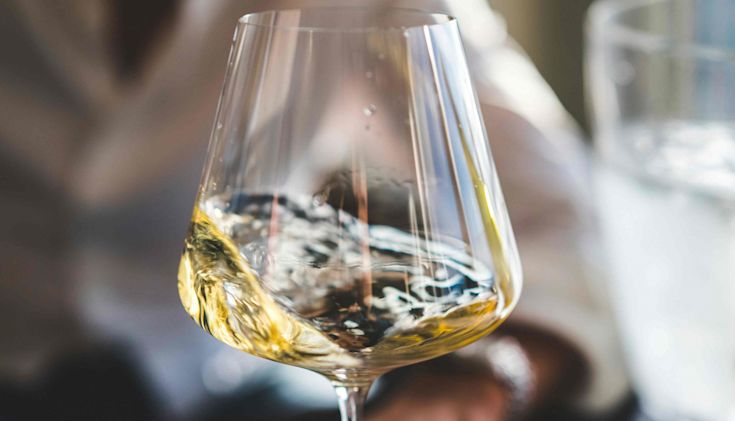Chat with Vinny
White wine comes in a huge array of styles, each with its own unique character and flavour. In this handy guide, we’ll explore 8 of the most popular types of white wine, what makes them special, and what foods to pair them with. Perfect for discovering your next favourite …
There are countless moments that call for a refreshing glass of white wine – think lazy summer picnics, sun-soaked beach days, back garden barbecues, a midweek treat alongside dinner, or simply a refreshing sip to awaken your taste buds.
But with so many white wine styles and varieties to choose from, the real challenge is knowing where to start …

White wine remains the UK’s most popular style
But that’s hardly surprising, especially with crowd-pleasers like Sauvignon Blanc, Pinot Grigio and Chardonnay at the forefront.
Of course, it’s easy to see why. White wine offers such incredible variety, from rich and luscious to dry and crisp, with flavours spanning from fresh herbs and tomato leaf to tropical fruits and honeysuckle.
No matter your preference, there’s a white wine to match. Now, let’s dive in and take a closer look at eight of the most popular white wine styles.
Popular styles of white wine
1. Sauvignon Blanc
Sauvignon Blanc is considered the UK’s favourite white style … and it’s not hard to see why. Capturing the essence of spring and summer, Sauvignon Blanc delights drinkers with its tantalisingly fresh flavours and explosive gooseberry, cut grass and guava aromas.
Sauvignon Blanc grown in cooler climates often benefits from longer growing seasons. This means grapes have higher acidity and more vibrant fruits, resulting in crisp wines with citrusy freshness, tropical fruit flavours (think passionfruit and guava) and that classic gooseberry-fresh character.
By contrast, Sauvignon Blanc grown in milder conditions result in riper grapes. This creates a richer style of Sauvignon, with melon, mango and stone fruits.
Some winemakers in Bordeaux, Napa Valley, and even New Zealand, occasionally ferment and/or oak age their Sauvignon Blanc. The result? A richer, fuller body with a creamier texture, and subtle notes of vanilla spice. It’s definitely different than a ‘standard’ Sauvignon, but an enjoyable twist, producing more of a savoury wine that’s often best with food.
New Zealand Sauvignon, particularly from Marlborough, is a must-try. This region is NZ’s Sauvignon capital, putting the country on the world stage for its Sauvignon Blanc. Expect wines with bright citrus and intense gooseberry flavours.
But, if you’d prefer something a little more classic, head to the Loire for Sancerre. Many rate the Loire Valley as the world’s best location for Sauvignon Blanc – and there’s certainly no shortage of exceptional examples. Expect richly textured, wonderfully aromatic expressions with peach, gooseberry and lemon flavours, with flinty undertones and a bracing acidity.

Sauvignon Blanc food pairings
When it comes to food pairings, Sauvignon Blanc is an incredibly versatile wine. Serve alongside:
White meats – grilled chicken or pork
Shellfish
Cod
Spicy Thai curries
Creamy pasta dishes
Tangy cheeses (goat’s cheese or feta)
Grilled vegetables
2. Chardonnay
Chardonnay is used to make some of the world’s most popular white wines. Its roots trace back to the Burgundy region in France … and it’s famed for fine whites like Chablis, Meursault and Montrachet.
Because of its adaptability, Chardonnay flourishes in wine regions all around the world. Winemakers love its versatility, its ability to thrive in various climates – and the different flavours this grape reveals, depending on where its grown.
In cooler climates, Chardonnay produces elegant expressions, revealing crisp flavours similar to Granny Smith apples, lemons and quince, with a touch of minerality. When grown in warmer climates, Chardonnay produces richer notes of pineapple, melon and apricot.
Chardonnay has a remarkable ability to showcase the unique characteristics of the region in which it’s grown – sometimes referred to as ‘terroir’. This grape beautifully mirrors the climate and soil of its vineyard. For example, chalky soils lend Chardonnay a bright, mineral character, while clay-rich soils bring out fruitier flavours in the wine.

You’ll often find that Chardonnay displays a lovely creamy texture and richness, a quality enhanced by winemaking techniques. Some winemakers choose to age the wine on its lees (the sediment that develops during fermentation) and occasionally stirring these lees adds depth and complexity. Another key process is malolactic fermentation, or ‘malo’ for short. This techniques softens the wine by transforming sharp malic acid (found in green apples), into smoother, milk-like lactic acid, resulting in a more rounded profile.
Chardonnay shines when it comes to oak ageing. Some of the best expressions gain complexity from fermentation in oak barrels, while others are fermented in tank, then aged in casks. Winemakers will use their judgement to carefully balance the oak’s influence on the wine, ensuring the toasty vanilla and spice notes complement the wine’s vibrant fruit flavours.
Chardonnay food pairings
Chardonnay is a food lover’s dream – pairing perfectly with a variety of foods.
Oaked Chardonnay:
Roast chicken
Rich salmon dishes
Unoaked Chardonnay:
Seafood – lobster and crab
Creamy pasta risottos
Vegetable dishes
Charcuterie boards
Semi-soft cheeses
3. Pinot Grigio / Pinot Gris
While Pinot Grigio and Pinot Gris are two names for the same grape, they signify very different styles. Much like Syrah and Shiraz, the name tells you what style to expect in the glass.
Pinot Grigio is the Italian name for this grape. You’ll find it growing throughout Italy, but it really thrives in the country’s northeast – particularly in Veneto, Friuli Venezia, Lombardy and Trentino-Alto Adige.
The style of Pinot Grigio can vary depending on winemaking techniques, but it’s typically light to medium bodied with high acidity. It delivers vibrant flavours of green apple, pear and citrus fruits … ideal for those who enjoy crisp, refreshing wines.
The French call this grape Pinot Gris. It’s originally from Burgundy, but you’ll rarely find it planted there now. Today, Pinot Gris is primarily grown in Alsace, where it takes on a richer, full-bodied profile. Because it’s a much riper style, expect white peach, hone, lemon, blossom and spice aromas. In Alsace and beyond, Pinot Gris is sometimes made into a luscious late-harvest wine.

Pinot Grigio food pairings
Seafood – grilled shrimp, mussels, cod
Light salads
Light pasta dishes
Sushi
Light Thai dishes
Charcuterie boards
Pinot Gris food pairings
Seafood – scallops, lobster, crab cakes
Roast turkey
Roast chicken
Glazed pork chops
Rich and creamy cheeses
Desserts (for late-harvest PG) – fruit tarts
Shop all Pinot Grigio and Pinot Gris wines.
4. Riesling
Riesling is one of the world’s most underrated white grapes – it has the ability to produce wines across the spectrum, from bone-dry to lusciously sweet.
Riesling is typically grown in cool climates, but because of its adaptability, it thrives in diverse climates and regions worldwide.
Its homeland is Germany, particularly in the Mosel Valley, where it’s been grown for centuries. Other key regions for German Riesling include Rheingau, Pfalz and Nahe.
When grown in cool climates, Riesling develops its signature high acidity, vibrant aromatics and an incredible ageing potential. Outside of Germany, notable Riesling regions include Alsace in France, Austria, Australia’s Clare and Eden Valleys and New Zealand.

Styles of Riesling:
Dry Riesling
Expect crisp and refreshing green apple and lime flavours with mineral notes.
Off-dry Riesling
Subtle residual sugar balances the vibrant acidity, lending peach, apricot and honey notes.
Sweet Riesling
Late-harvest or botrytised Rieslings are rich and complex, with layers of dried fruit, honey and floral notes.
Sparkling Riesling
Some regions craft sparkling Rieslings, further highlighting this grape’s wonderful acidity and aromatic profile.
Riesling food pairings
Its high acidity makes Riesling a food-paring champion – its versatility lends it to almost any dish or occasion. Here are just a few suggestions of what dishes to pair across the range of styles.
Dry:
Grilled seafood
Light salads
Sushi
Off-dry:
Thai green curry
Spicy Indian dishes
Sweet:
Creamy desserts – fruit tarts, crème brûlée
Savoury blue cheeses
Sparkling:
Roast pork
Mushroom risotto
5. Chenin Blanc
Chenin Blanc is best known for producing wines with high acidity, green apple flavours and distinctive honeyed notes. Like Chardonnay, it’s an exceptionally versatile grape, creating wines in various styles – from sparkling to still, and dry to deliciously sweet.
Chenin Blanc hails from France’s scenic Loire Valley, but it’s now grown worldwide – everywhere from South Africa to Australia, New Zealand and North America.
This grape is celebrated for its vibrant fruit flavours, often revealing notes of green apple, pear and quince in drier styles, with richer expressions offering hints of apricot, honey and tropical fruits like guava and pineapple.

Chenin Blanc’s natural acidity ensures freshness in every sip – and means it has fantastic ageing potential. When aged in oak, Chenin Blanc develops butterscotch, baked apple, marzipan and nutmeg flavours.
This adaptability extends to food pairings, as you’ll see below. And, if you’re a dessert lover, late-harvest or botrytised Chenin Blanc is a real treat. It stands alongside Sauternes as one of the top dessert wines, bursting with candied fruit and marmalade flavours.
Chenin Blanc food pairings
Pork
Chicken with creamy sauces
Thai green curry
Pad Thai
Seafood – lobster or crab
Mild, creamy cheeses
6. Viognier
Viognier is one of the fastest growing white styles in our range. In fact, sales of these luscious wines have skyrocketed by 237% since 2019.
It’s quite remarkable, really, especially when you consider that just half a century ago, plantings of this aromatic grape had dwindled so much that it was on the brink of distinction. And while Viognier’s homeland is in France’s Rhône Valley, it is producers in South Africa and Australia who have caused a resurgence in this star grape.
But it’s not an easy grape to grow. In fact, it ripens unevenly and is prone to disease. Why do winemakers choose to use it then?
Simple. The outcome is truly rewarding. Viognier produces richly aromatic wines, with lashings of stone and citrus fruits – I’m talking peaches, apricot, mango and tangerine – lovely acidity and mouthwatering spice.
Viognier food pairings
Seafood – lobster, scallops, crab
Roast turkey
Roast chicken
Roast pork
Sweet-spicy curries
Thai rice
Mild, creamy cheeses

7. Semillon
Semillon doesn’t demand the spotlight like Sauvignon Blanc or Chardonnay. It’s usually found in blends, but can produce some wonderfully characterful whites on its own.
Originally from Bordeaux, Semillon is the cornerstone of some of the world’s most famous wines, from deliciously sweet Sauternes to the dry, citrusy blends in Graves.
Semillon is hugely popular in Australia, especially in Hunter Valley. Here, you’ll typically find dry, unoaked wines with superb ageing potential, starting as zesty while young, and developing a honeyed, nutty complexity over time.

Styles of Semillon:
Dry Semillon
This style is crisp and vibrant often found in expressions from Bordeaux and Hunter Valley. Expect rivers of lemon, lime and green apple flavours. When aged, it develops complex notes of honey and nuts, adding a creamy texture.
Blended Semillon
Semillon is often blended with Sauvignon Blanc, adding richness, weight and a silky texture to the wine.
Sweet Semillon
Semillon is the grape behind the iconic dessert wine Sauternes. This style is wonderfully rich, with flavours of honey, marmalade, apricot and spice.
Semillon food pairings
Dry:
Light chicken dishes
White fish
Creamy pasta
Risotto
Blends:
Seafood platters
Roasted vegetables
Pesto pasta
Sweet:
Fruit tarts
Blue cheeses – Roquefort
Crème brûlée
8. Grüner Veltliner
Grüner Veltliner is Austria’s signature grape. In fact, Austrian winemakers are responsible for 75% of the world’s Grüner Veltliner wines.
Outside of Austria, you’ll find plantings in Italy, Canada, parts of North America and South Australia. Grüner Veltliner prefers hillsides, thriving in vineyards with mineral-rich soils. This is particularly important when grown in a warmer climate, as the cool evening breezes in these regions prevent the grape from over-ripening, retaining the grape’s natural acidity.
Expect green apple, citrus and white pepper flavours with high acidity in youthful expressions. When aged, Grüner Veltliner wines become fuller-bodied and richer, with notes of ripe melon and honey.
Grüner Veltliner are similar in style to some Rieslings – dry, full of citrus and spice – but it’s also a superb alternative to Sauvignon Blanc.
Grüner Veltliner food pairings
Light summer salads
White fish
Spicy Thai or Indian dishes
Vegetables
Roast pork
Roast chicken
Soft cheeses

Other types of white wine
There are many different types of white wine besides the ones you might know already. Here are some of these lesser-known white wines and their unique characteristics.
Albariño
Albariño is one of Spain’s most celebrated white grapes, renowned for its exceptional purity and vibrant character. Gloriously refreshing, these wines sing with a melody of zesty citrus, floral blossoms and minerality, often underlined by a subtle salinity.
It’s primarily grown along the Iberian Peninsula, in Spain’s Rías Baixas region and Portugal’s Vinho Verde region (here it is known as Alvarinho).

Gewurztraminer
If you’re feeling adventurous and want to try something new in the world of white wine, we’d recommend Gewurztraminer.
Bold and unapologetically aromatic, expect pronounced floral aromas (lychee, roses and ripe peaches), with a hint of spice and rich texture.
When it comes to Gewurztraminer wines, France’s Alsace region wears the crown, producing both dry and sweet late-harvest wines that are nothing short of mesmerising.
Muscat
Muscat is one of the most ancient and versatile grape varieties, loved for its aromatic character and for the wide range of styles it can produce. From light and sparkling wines, to rich, sweet dessert expressions, Muscat always delivers a plethora of vibrant flavours and aromas.

About the author
Brogan Wilson
Qualified to WSET Level 2 Wine, Brogan is a relatively new member of the team, having joined in September 2023. She previously worked as the sole copywriter at a creative marketing agency, and before that, as a primary school teacher. At Laithwaites HQ, you’ll find her growing her knowledge, asking lots of questions, and crafting both digital and print copy. An ardent red wine drinker, Brogan is also fond of Crémant.

